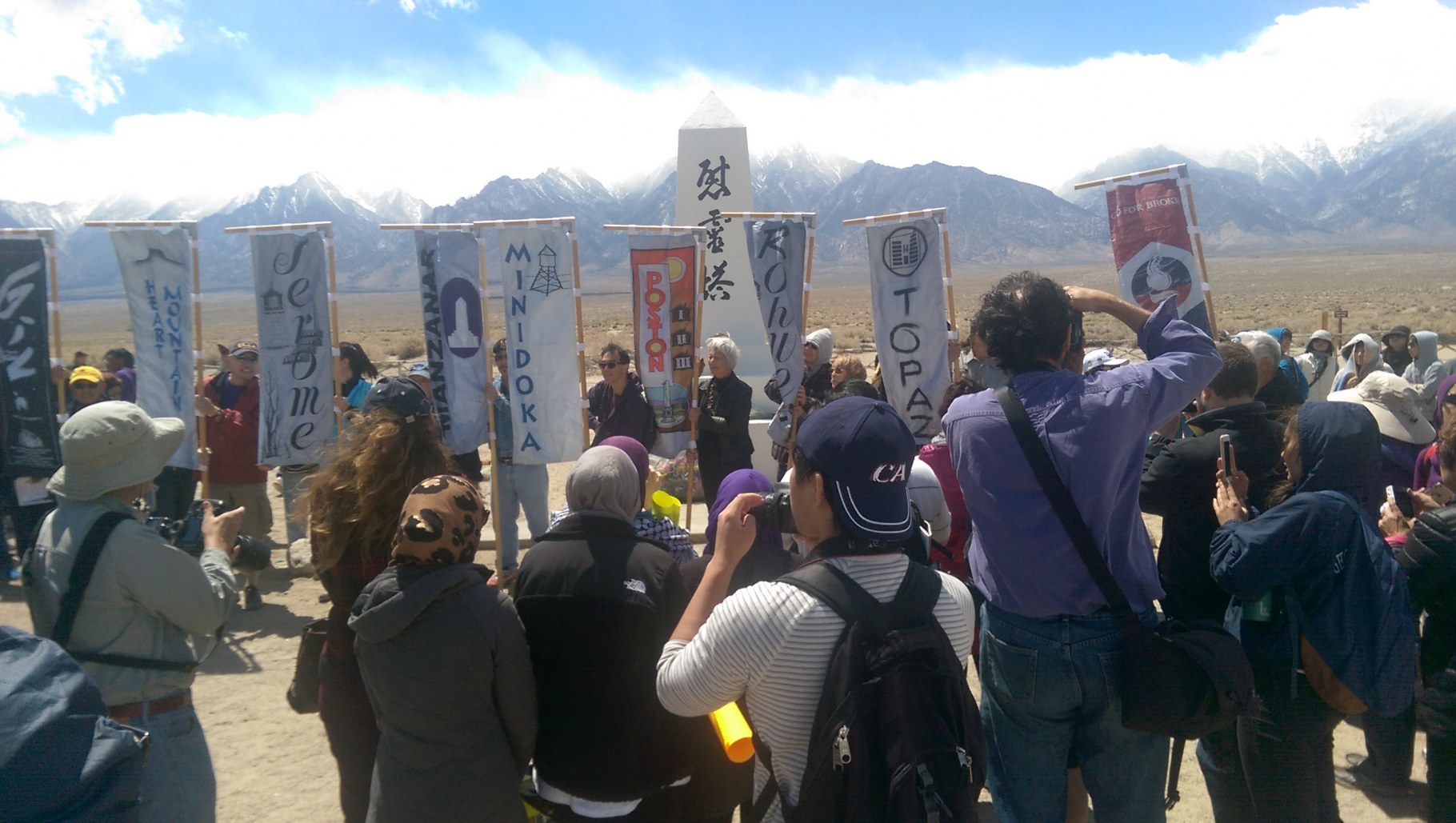“Remembering Manzanar”. A reflection by Megan Asaka.
As we stepped off the bus at Manzanar and into the swelling crowd, my mind wandered back to early scenes from the documentary, “Pilgrimage,” which explore the origins of the Manzanar pilgrimage and feature interviews with the very first pilgrims, mostly third generation Japanese Americans who were searching for answers to what happened to their parents and grandparents and even themselves during WWII. Very little information about the incarceration existed at that time beyond the vague references to “camp” they heard from their parents growing up. Radicalized by the Vietnam War and Asian American Movement, they organized “a march” from LA to Manzanar, setting off in a bus and unsure of what they would find. They encountered a deserted site, recognizable only by the white memorial marker inscribed with Japanese characters that stood out “like a beacon.” Other physical remains included a garbage pit filled with broken pottery and a handful of gravestones. Video footage shot by the group captured this physical abandonment but also the magnitude of their (re)discovery; they decided at that moment to organize what would become an annual pilgrimage back to Manzanar to pay their respects and honor what their families had endured.
Today, the Manzanar pilgrimage and the landscape itself have transformed into something much different, a symbol of injustice, a place for learning and public education, a recipient of federal resources and grants. Newly reconstructed barracks show visitors how internees lived, while an interpretive center tells the story of Manzanar as well as the broader history of the WWII incarceration. Over one thousand people gathered to participate in this year’s pilgrimage, the majority non-Japanese American from what I could tell. I left Manzanar that weekend struck by the ambivalence of these public commemoration and preservation efforts. As someone who has worked professionally to raise awareness about Japanese American history and make the story of the WWII incarceration more accessible to the public, the enormous crowd that had assembled to witness the pilgrimage was touching and extremely gratifying. Yet, as I stood in the back during the main program, with the stage almost totally obscured by the audience, I felt very removed from the actual pilgrimage experience, despite (or perhaps because of) my own family connection to Manzanar. The place itself does not hold the same kind of meaning for me today as it once did for those first pilgrims even though I too grew up in the shadow of the incarceration and also grapple with questions of identity and history and community. Manzanar is no longer for me, I realized, but for everyone.
The pilgrimage weekend and visit to Manzanar revealed the paradox of Japanese American public preservation. As the site becomes more popular and better funded, reaching wider and more diverse audiences, it somehow becomes less relevant to those of us whose lives have been shaped by the wartime incarceration and its aftermath. This seems to be particularly true for the younger generations like me who did not live through the incarceration, yet still feel its effects in the silences and traumas that continue to play out in our families and communities. Further, while the renewed focus on educating the public about what happened at Manzanar through reconstructed barracks, archaeological digs, and first-person accounts by former detainees offers an invaluable learning experience, these projects also obscure the postwar history of the site itself, what Manzanar looked like when no one, certainly not the federal government, cared about preserving it. Many of the first pilgrims have expressed their deep sense of fulfillment about what Manzanar stands for today, particularly as it relates to Arab and Muslim Americans and immigrant groups who look to the site for inspiration in their own struggles for social justice. Yet, I couldn’t help but think that these pilgrims, and the grassroots movement they initiated and sustained back in the 1970s, have become dispossessed of their place in the collective memory of Manzanar, particularly as the site embraces historical reconstruction and other public education projects that resonate with broader audiences. The preservation of Manzanar is so often discussed in unequivocally positive terms – as a rare success story and fundamentally good and noble project – that we don’t stop and think about the losses that have accompanied this growth and success, losses that I felt acutely during the weekend even as I admired what it has become.

